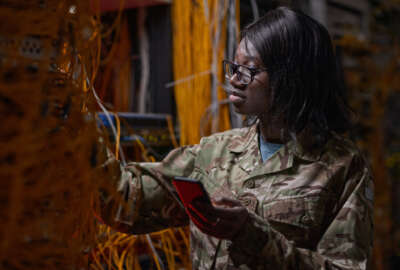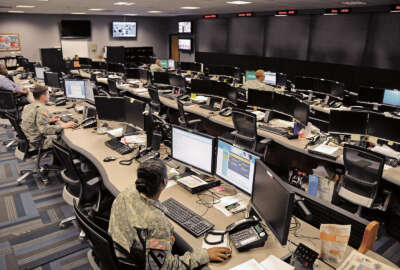Army moving closer to having global access to secret network
The Army launched the first phase of Global Commercial Solutions for Classified. It is expected to reach initial operational capability by fiscal 2025.
The Army has just kicked off the first phase of Global Commercial Solutions for Classified (CSfC), the National Security Agency’s program that uses commercial security technologies to protect classified information. It is expected to reach initial operational capability by next summer.
Part of that effort is implementing a secure internet protocol router (SIPR)-consolidated security suite (SCSS), which will allow soldiers to access classified networks securely from anywhere in the world.
“Global Secure Network, formerly Global SIPR Network — that is basically the enterprise solution to actually allow separate traffic to route commercial networks based on NSA’s CSfC technology,” Lt. Col. Xkoshan Arnold, the Global Enterprise Network Modernization — Americas product manager, said during the AFCEA Belvoir Industry Days event Tuesday.
The Global Enterprise Network Modernization — Americas product office, which is part of Project Manager Integrated Enterprise Network (IEN), is tasked with bringing standardized and modernized networking solutions across Army’s facilities.
For the past four years, the Army has been working toward its unified network plan. The goal is to collapse the majority of the Army’s networks and link its tactical battlefield networks with enterprise networks by 2027.
Global Security Network is also a priority for the Global Enterprise Network Modernization —OCONUS product office. Tom Dunaway, the office’s product manager, said although Arnold’s office is in charge of the effort, it’s crucial the two offices are aligned.
“I was out talking to the Pacific folks and to the Europe folks last week. This is a critical enabler for them. To the point where what used to keep me up at night, but I feel a little less worried about — and that is commanders often would go out and buy their own capability because the [product manager] couldn’t move fast enough. And that’s the reality that we live in,” said Dunaway.
“Now, for the last three years, we’ve been trying to get commanders aligned with where we’re going. And I think we’re starting to get there where 2nd Signal Brigade commander in Europe told me last week, ‘I’m really putting the handcuffs on commanders in theater that want to get their own CSfC solution. But you got to feed us faster.’”
In addition, Dunaway said the service expects to award the Army Global Unified Network contract at the end of the year.
“We’re really looking forward to awarding that contract in the fourth quarter and delivering one of the top three priorities for Lt. Gen. John Morrison in the G-6,” said Dunaway.
Arnold’s office has also been focused on voice modernization, an important effort for the Army to reduce the overall phone count and transition its soldiers to internet-based communication systems. The service is phasing out the time-division multiplexing (TDM) switches and removing primary rate interface lines — a type of digital telephone line — by March 2025.
“We are neck-deep in that,” said Arnold.
Dunaway’s number one goal is also divesting of all the legacy telephone hardware.
“We’re in the midst of doing that; we finished Southwest Asia and Pacific. We’re full steam ahead in Europe, getting rid of the last 26 to 30 TDMs and getting them on a [voice over internet protocol] infrastructure,” said Dunaway.
The product office also has a request for proposal out for the Comprehensive Modernization (COMPMOD) Program, which will provide support for modernization and expansion of all types of IT systems for the Army.
“The overall concept of COMPMOD is delivering all the capabilities that we’re charged with under one systems integrator,” said Arnold.
Copyright © 2025 Federal News Network. All rights reserved. This website is not intended for users located within the European Economic Area.






